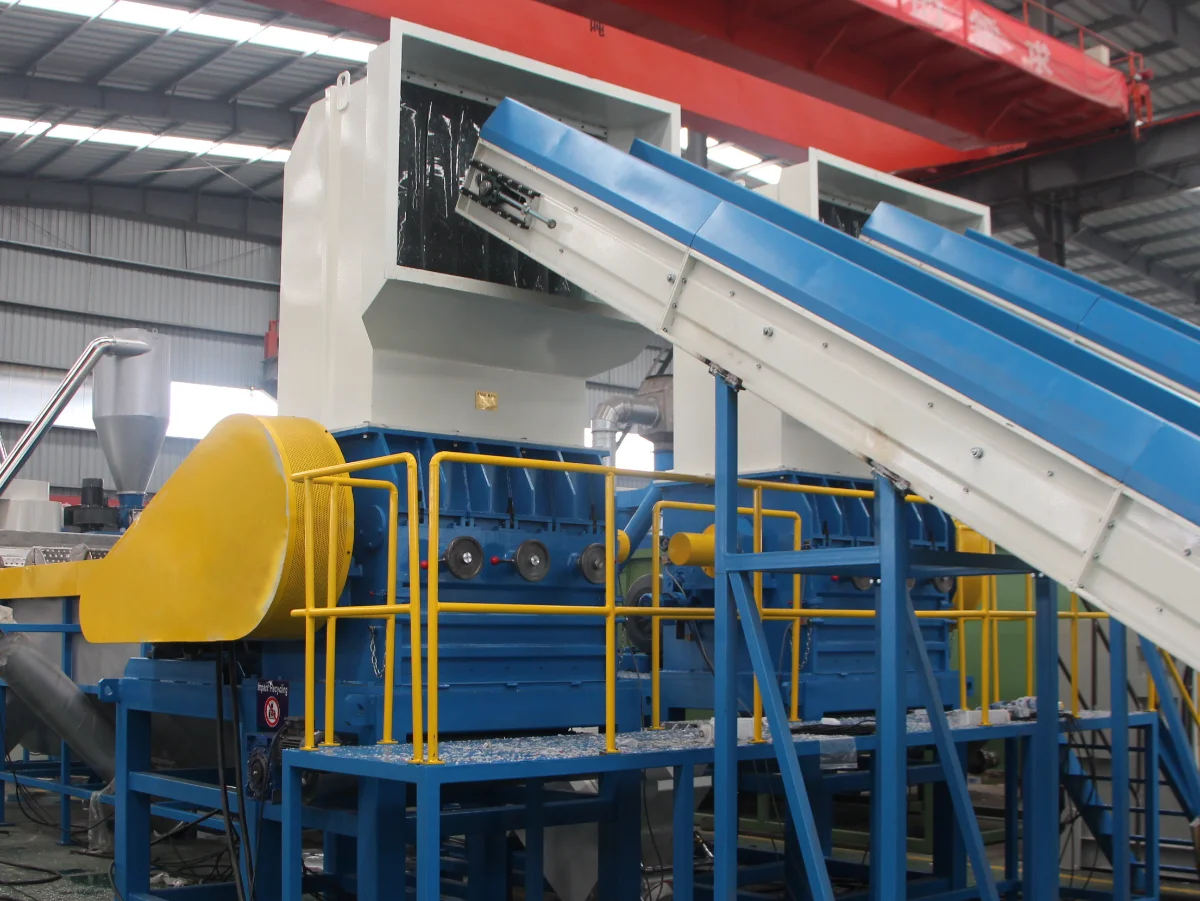Feuchtige Kunststoffmahlmaschinen: Ein umfassender Leitfaden für Recyclingbetriebe
Feuchtige Kunststoffmahlmaschinen sind ein Eckpfeiler moderner, effizienter Kunststoffrecyclinganlagen. Durch die direkte Zufuhr von Wasser in den Zerkleinerungsprozess übernehmen diese Maschinen mehr als nur das Granulieren von Kunststoff; sie waschen gleichzeitig die Materialien vor, verlängern die Lebensdauer der Anlagen und schaffen ein sichereres Arbeitsumfeld. Für Recyclingprofis und Betriebsleiter ist das Verständnis der Mechanik, Vorteile und Anwendungen dieser Technologie unerlässlich, um die Durchsatzleistung zu optimieren, die Qualität des Recyclingmaterials zu verbessern und die Profitabilität zu steigern.
Dieser Leitfaden bietet eine detaillierte Untersuchung von feuchten Kunststoffmahlmaschinen, ihren Betriebsprinzipien, den entscheidenden Unterschieden zwischen feuchter und trockener Zerkleinerung sowie praktische Tipps zur Auswahl und Wartung der richtigen Ausrüstung für Ihre spezifischen Bedürfnisse. Wir werden erkunden, wie die Integration eines leistungsstarken feuchten Granulators Ihre Recyclinglinie revolutionieren kann.

Was ist eine feuchte Kunststoffmahlmaschine?
Eine feuchte Kunststoffmahlmaschine, oft auch als feuchter Granulator bezeichnet, ist eine Zerkleinerungsanlage, die einen hochgeschwindigkeitsrotor mit scharfen Messern verwendet, um große Kunststoffgegenstände in kleine, einheitliche Flocken oder Neugranulate zu zerkleinern. Ihr markantes Merkmal ist die kontinuierliche Injektion von Wasser in den Zerkleinerungskammer während des Betriebs.
Dieses Wasser erfüllt mehrere entscheidende Funktionen:
- Kühlung: Es kühlt aktiv den Rotor, die Messer und den Kunststoff selbst ab, verhindert das Schmelzen des Materials durch Reibung und ist besonders wichtig für Kunststoffe mit niedrigem Schmelzpunkt wie LDPE-Folie.
- Reinigung: Der Wasserstrahl agiert als mächtiges Reinigungsmittel und spült Verunreinigungen wie Schmutz, Sand, Papieretiketten und Lebensmittelreste von der Oberfläche des Kunststoffes ab.
- Schmierung: Es schmiert den Schnittprozess, reduziert den Reibungswiderstand und den Verschleiß der Messer.
- Staubunterdrückung: Das Wasser fängt feine Kunststoffpartikel und Staub ein und verhindert, dass sie in die Luft gelangen, was einen saubereren und sichereren Arbeitsplatz für die Bediener schafft.
Das resultierende Produkt ist eine Mischung aus sauberen Kunststoffflakes und kontaminiertem Wasser, die anschließend getrennt werden. Die sauberen Flakes können in den nächsten Schritt des Recyclingprozesses, wie z.B. eine Reibungswaschanlage oder einen Schwimmbecken, mit einem erheblichen Vorsprung an Sauberkeit übergehen.
Der Feuchtvermahlungsprozess: Eine Schritt-für-Schritt-Analyse
Das Verständnis des Betriebsablaufs eines feuchten Kunststoffvermahlers hilft, seinen Wert innerhalb eines größeren Recycling-Systems zu verdeutlichen. Obwohl die Designs zwischen Herstellern variieren, bleibt der Kernprozess konstant.
- Materialzufuhr: Vorscherung oder Ganzes:.
- Vorscherter oder unzerkleinerte Kunststoffgegenstände wie PET-Flaschen oder HDPE-Kanister werden in den Schredderhopper eingeführt, typischerweise über eine Förderschnecke. Wassereinspritzung:.
- Wenn das Material in den Schnittkammerbereich eintritt, sprühen aus einer Reihe von Düsen kontinuierlich Wasser auf den Kunststoff und die Schneidkomponenten. Die Wassermenge und der Druck können oft je nach Materialart und Kontaminationsgrad angepasst werden. Zerkleinerung (Granulation): Ein schwerer Rotor, der mit hohen Geschwindigkeiten (typischerweise 400-600 U/min) rotiert, drückt den Kunststoff gegen stationäre Schneidklingen. Der Scherbewegung der Rotor- und Schneidklingen gegen die Schneidklingen schneidet das Material in kleinere Stücke.
- Sichtbarkeits- und Größenanpassung: Die Schneidkammer wird von einem perforierten Sieb umgeben. Das Material bleibt innerhalb der Kammer und wird kontinuierlich zerkleinert, bis es klein genug ist, um durch die Löcher im Sieb zu passieren. Die Lochgröße des Siebs bestimmt die endgültige Flakengröße.
- Entladung: Die Mischung aus korrekt dimensionierten Kunststoffflakes und Wasser verlässt die Maschine durch einen Entladeausgang am Boden. Dieser Brei wird dann oft mit einem Schaufelrührer oder einer Pumpe transportiert, um zum nächsten Gerät in der Waschanlage zu gelangen.
Feucht- versus Trockengrindung: Eine direkte Gegenüberstellung
Für jede Recyclingoperation ist die Wahl zwischen einer feuchten und einer trockenen Granuliermaschine von großer Bedeutung. Eine trockene Granuliermaschine arbeitet ohne Wasser und nutzt Luftsaugung, um das Material zu evacuieren und Staub zu kontrollieren. Hier ist eine Gegenüberstellung der beiden Maschinen hinsichtlich wichtiger Betriebsparameter:
| Besonderheit | Feuchte Kunststoff-Grindmaschine | Trockene Kunststoff-Grindmaschine |
|---|---|---|
| Sauberkeitseffizienz | Hoch. Integriert einen Vorwaschschritt, der Oberflächenstaub, Papier und Klebstoffe effektiv entfernt. | Niedrig. Verunreinigungen werden zusammen mit dem Kunststoff granuliert und erfordern eine intensivere Nachwaschung. |
| Staubkontrolle | Wasser unterdrückt fast alle Stäube, verbessert die Luftqualität und erhöht die Sicherheit am Arbeitsplatz. | Benötigt eine separate, energieintensive Luftabzugs- und Filtrationssysteme, um Staub zu bewältigen. |
| Klingenlebensdauer | Länger: Wasser kühlt und schmiert die Messer, reduziert den Verschleiß durch Hitze und Reibung. Abrasive Materialien wie Sand werden entfernt, was das vorzeitige Abnutzen verhindert. | Kürzer: Messer sind höheren Temperaturen und erhöhter Reibung ausgesetzt, was häufigeres Schärfen oder Ersetzen erfordert. |
| Energieaufnahme | Kann den Gesamtwirkungsgrad des Systems senken, da die Belastung des nachfolgenden Wascheinrichtung reduziert wird. | Der Granulator selbst verbraucht möglicherweise etwas weniger Energie, aber der Gesamtwirkungsgrad des Systems ist höher, da leistungsstarke Staubabsaugsysteme erforderlich sind. |
| Ideale Anwendungen | Post-konsumierte Kunststoffe (PET-Flaschen, HDPE-Container), landwirtschaftliche Folien und andere kontaminierte Materialien. | Reinige, internes industrielles Schrottmaterial (z.B. Sprühschläuche, Leitungen) bei dem keine Kontamination vorliegt. |
| Wartung | Erfordert die Verwaltung des Wassersystems (Filter, Pumpen). Weniger häufige Messerwartung. | Erfordert die regelmäßige Reinigung der Staubabsaugfilter. Häufigere Messerwartung. |
Kerneigenschaften der Integration von Feuchtvermahlung in Ihre Arbeitsabläufe
Die Einführung von Feuchtvermahlmaschinen für Kunststoff bietet konkrete Vorteile, die direkt die Betriebswirtschaftlichkeit und die Qualität des Endprodukts beeinflussen. Die Association of Plastic Recyclers (APR) stellt strenge Richtlinien für die Qualität von Recyclingmaterialen auf, und die Feuchtvermahlung hilft, diese Standards zu erfüllen.
Überlegene Schadstoffentfernung
Bei Post-Konsumenten-Kunststoffen stellt die Kontamination die Hauptherausforderung dar. Die Feuchtvermahlung angeht dies konsequent an. Der kraftvolle, kontinuierliche Wasserstrom löst Schmutz, verbleibende Flüssigkeiten und Lebensmittelreste ab. Sie hilft auch, Papier und Klebstoff von Etiketten zu trennen, was ein entscheidender Schritt für die Herstellung hochreiner PET-Flocken für das Flaschen-zu-Flaschen-Recycling ist.
Erweiterte Messer- und Maschinenlebensdauer
Die Betriebskosten eines Granulators werden stark durch den Wartungsplan für die Messer beeinflusst. Durch das ständige Kühlung der Schnittflächen verhindert eine Feuchtvermahlmaschine, dass die Messer durch übermäßige Hitze ihre Härte und Zähigkeit verlieren. Dies führt direkt zu längeren Intervallen zwischen Schärfen und Austausch, reduziert Stillstandszeiten und die Kosten für Ersatzteile. Der Schmierungseffekt minimiert auch die Belastung von Lagerungen und dem Rotor.
Verbesserte Sicherheit am Arbeitsplatz und Einhaltung von Umweltvorschriften
Kunststoffstaub ist eine ernsthafte Berufskrankheit. Er kann eine Atemwegsreizung verursachen und bei hohen Konzentrationen brennbar sein. Wie die Occupational Safety and Health Administration (OSHA) betont, ist die Verwaltung brennbaren Staubes eine wichtige Sicherheitspriorität. Die Feuchtvermahlung beseitigt den Staub effektiv an der Quelle, schafft eine viel sicherere Arbeitsumgebung und vereinfacht die Einhaltung von Luftqualitätsvorschriften.
Verbesserte Qualität und Wert der recycelten Flocken
Das Ziel des Recyclings ist es, ein hochwertiges Rohmaterial zu produzieren. Sauberere Flocken erzielen einen höheren Preis auf dem Markt. Durch eine aggressive Vorwäsche erzeugen Feuchtvermahlmaschinen Flocken, die erheblich sauberer sind als die aus einem trockenen Prozess. Dies verringert die Belastung der nachfolgenden Waschstufen, lässt sie effektiver arbeiten und führt zu einem Endprodukt mit niedrigeren Kontaminationsgraden.
Schlüsselfunktionen und geeignete Kunststoffmaterialien
Feuchte Kunststoff mahlende Maschinen sind vielseitig einsetzbar, aber sie überzeugen in bestimmten Anwendungen, wo ihre Reinigungsfähigkeiten den größten Wert bieten.
- PET-Flaschen: Dies ist die Hauptanwendung. Feuchte Mahlmaschinen entfernen effizient Papieretiketten, Kleber und Getränkereste und liefern saubere Schuppen, die für die Aufschüttelungstanks bereit sind.
- HDPE-Container: Milchflaschen, Detergensflaschen und andere HDPE-Container werden effektiv verarbeitet. Das Wasser hilft, Produktreste und Schmutz abzuwaschen.
- Verunreinigte Kunststofffolien: Agrarfolien (Mulchfolien, Gewächshausabdeckungen) sind oft stark verschmutzt. Feuchte Mahlung bietet die erforderliche aggressive Reinigung, um sie recycelbar zu machen.
- Gemischte Hartkunststoffe: Bündel gemischter nachverbrauchter Kunststoffe aus Haushaltsabfällen profitieren erheblich vom integrierten Waschprozess.
Bei Energycle-Maschine, Wir gestalten unsere Ausrüstung so, dass sie die härtesten Materialien bewältigen kann, um eine zuverlässige Leistung über eine Vielzahl anspruchsvoller Anwendungen zu gewährleisten.
Die richtige feuchte Kunststoffmahlmaschine für Ihre Bedürfnisse auswählen
Die Auswahl der richtigen Maschine erfordert eine sorgfältige Analyse Ihrer spezifischen Betriebsanforderungen. Berücksichtigen Sie diese Faktoren:
- Verwendet hochgeschwindige Schaufeln, um PVC-Streifen zu schrubben und Schmutz, Etiketten und andere Oberflächeverunreinigungen zu entfernen. Wie viel Material müssen Sie pro Stunde verarbeiten (kg/h oder lbs/h)? Wählen Sie eine Maschine mit einer Kapazität, die Ihre aktuellen Bedürfnisse komfortabel übersteigt, um zukünftiges Wachstum zu ermöglichen.
- Eingangsmaterial: Art des Plastikmülls: Typ, Größe und Kontaminationsgrad. Stark kontaminierte oder voluminöse Materialien könnten eine Maschine mit einem größeren Schnitt腔 und einem robusteren Rotor erfordern.
- Wünschtes Granulatgröße: Der endgültige Granulatgröße wird durch das Sieb bestimmt. Stellen Sie sicher, dass der Hersteller Screens mit dem angemessenen Lochdurchmesser für Ihre Ziel specification liefern kann.
- Motorleistung: Motor (in HP oder kW): Der Motor muss leistungsstark genug sein, um Ihre härtesten Materialien zu handhaben, ohne zu blockieren. Unterdimensionierte Maschinen führen zu niedriger Durchsatz und häufigen Verstopfungen.
- Konstruktion und Haltbarkeit: Suchen Sie Maschinen, die mit schwerem, abrasionsfestem Stahl gebaut sind. Der Schnitt腔 und der Rotor sollten so gestaltet sein, dass ein einfacher Zugang für den Wechsel der Messer und die Reinigung ermöglicht wird.
Wartung und Betriebspraktiken für maximale Leistung:
Um die Lebensdauer und Effizienz Ihres feuchten Plastikmahlers zu maximieren, ist ein ständiger Wartungsplan unverhandelbar.
- Tägliche Kontrollen: Vor dem Start: Inspecten Sie den Schnitt腔 visuell auf fremde Objekte (wie Metall), die die Messer beschädigen könnten. Überprüfen Sie auf Wasserlecks.
- Klingenwartung: Regelmäßig: Inspecten Sie die Messer auf Abnutzung und Schäden. Drehen und schärfen Sie sie gemäß den Empfehlungen des Herstellers. Die Wartung eines präzisen Messerraums ist entscheidend für einen sauberen, effizienten Schnitt.
- Sievesreinigung: Stellen Sie sicher, dass das Sieb von Verstopfungen befreit ist. Verstopfte Siebe reduzieren den Ausstoß und können dazu führen, dass Material im Innenraum überhitzt.
- Lagerschmierung: Befolgen Sie den empfohlenen Schmierungstermin für die Rotorlager, um vorzeitige Ausfälle zu verhindern. Hören Sie auf nach ungewöhnlichen Geräuschen, die auf ein Lagerproblem hinweisen könnten.
- Wassersystem Wartung: Überprüfen und reinigen Sie regelmäßig die Wasserinlettfilter, um einen konsistenten Durchfluss und Druck sicherzustellen. Die Qualität des verwendeten Wassers kann sowohl die Reinigungseffizienz als auch den Verschleiß der Maschine beeinflussen.
Durch die Implementierung dieser Praktiken stellen Sie sicher, dass Ihre Ausrüstung auf bestem Niveau arbeitet. Unser Team kann maßgeschneiderte Unterstützung und Anleitung für die Wartung unserer fortschrittlichen feuchten Plastikgranulatoren für langfristigen, störungsfreien Betrieb bieten.
Ansicht der Spezifikationen des feuchten PlastikgranulatorsDie Plastikrecyclingindustrie entwickelt sich kontinuierlich, um wachsende Anforderungen an hochwertige recycelbare Materialien zu erfüllen. Laut der U.S. Environmental Protection Agency (EPA) bleibt die Recyclingquote für Plastik ein entscheidender Bereich für die Verbesserung, sodass effiziente Verarbeitungstechnologie wichtiger als je zuvor ist. (Quelle: U.S. EPA) Feuchte Plastikmahlmaschinen sind eine direkte Antwort auf diese Herausforderung und bieten eine zuverlässige und effektive Methode, kontaminierten Plastikmüll in ein wertvolles Material umzuwandeln.Ein feuchter Plastikmahlmaschine von Energycle Machine im Betrieb, Plastikflaschen mit Wassernebel verarbeitend.



